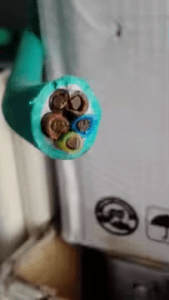1. What is XLPE Cable?
XLPE (Cross-Linked Polyethylene) cable is a cable with XLPE sheath, VDE Code: 2X. Sometimes we also call this cable VPE Cable.
In the previous article we mentioned that PE cables have poor weathering and thermal properties and cannot be used directly as cable sheathing. To solve this problem, XLPE sheathed cables were invented.
XLPE material is a material produced by cross-linking PE material. After cross-linking, the abrasion resistance and weather resistance of the material will significantly improve, while the hardness and stiffness will reduce.
2. Characteristics of XLPE Cables
Electrical Performance
- Breakdown Voltage (20℃): 50KV/mm
- Specific Volume Resistivity (20℃): 10¹² – 10¹⁶ Ohm*cm
- Dielectric Constant (50Hz, 20℃): 4-6
- Dielectric Factor: 2×10⁻³
Thermal Performance
- Working Temperature: -35~90°C
- Flame Resistance: Flammable
- Halogen-Free: Yes
Mechanical Performance
- Tensile Strength: 12.5-20 N/mm²
- Elongation at Break: 300-400%
- Shore Hardness: 40-45 (D)
- Corrosion Behavior: Medium
Weather
Weather Resistance: Good
Cold Resistance: Good
As you can see, XLPE cable not only maintains the original excellent electrical properties of PE cable, but also improves many other properties significantly compared to PE cable. However, XLPE material is still flammable, so many high voltage cables are with PVC or LSZH sheath.

3. Applications of XLPE Cables
High Voltage Cables
The most common application of XLPE cables is in high voltage cables. The vast majority of cables used in urban power grids are insulated with XLPE, which can be buried directly in the ground or laid in conduits.
The most common types of high voltage cables are: N2XY, YJV.
Automotive Cables
There are some American standard automotive cables, people also use to XLPE cable. The main reason for this is the heat resistance of XLPE material as well as its electrical properties. Compared with the PVC material, XLPE car wire has smaller diameter, lower weight, and higher heat resistance, which is more suitable for the internal wiring of the car.
Some of the most common types of XLPE automotive cables are: TXL SXL
4. Conclusion
Understanding the characteristics and performance of XLPE cables helps us to find the right cable. Want to learn more about cable material? Please visit this blog.
Any further requirements, please feel free to contact us for any requirements.

